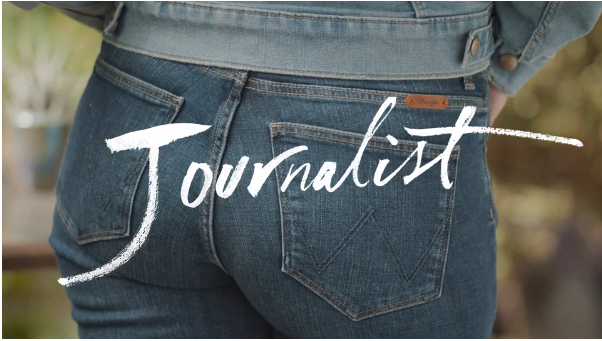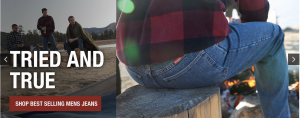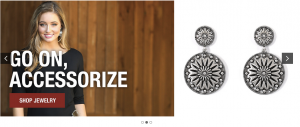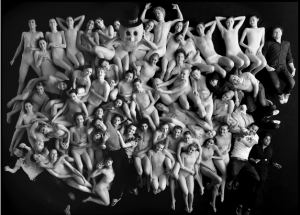
One of our Arts and Technology PhD students, James Martin, forwarded me this story in which the author, Maggie Parker, asks “Is this denim ad accidentally sexist?” In the email, the student asked me, “how do companies keep making the same mistakes?” The mistake in question is that Wrangler made an ad that attempts to position women as “more than a bum.” Instead of liberating women from the male gaze, however, they end up reinscribing the very thing they suggest that they are resisting. From the opening shot that is focused on Kimbra from behind, to the series of shots like the one that I included above, to the lack of older or disabled bodies, to the normative depiction of femininity, I agree with Parker that it’s a #FAIL. They do deserve some credit for a few things: a racially diverse cast; not just including cis-gendered women; and including a few curvier bodies, even if they never show those bodies in jeans or from behind.[footnote]I admit that this may seems like a contradiction. I’m critiquing them for reducing some women to body parts, right? Yes. But also, I’m mad that they didn’t reduce these other women to body parts? Yes. I don’t want them to reduce anyone to body parts. But in the world in which they have already done this, and in which they do not show any but the smallest of women from behind, they are implicitly suggesting that other bodies are not desirable. So it makes a bad situation worse.[/footnote] For more analysis of the contradictions in the ad, check out Parker’s piece linked above. The rest of this post takes for granted that the ad is sexist and focuses on the question, “how do companies keep making the same mistakes?” James, the student who sent me the story, suggested in exasperated disbelief that perhaps Wrangler knew what they were doing and this is a misguided effort to get people talking, in keeping with the old adage, “there is no such thing as bad publicity.”
As entertaining as a good conspiracy theory might be, there is probably a more straightforward answer.
Let’s start with Wrangler. The company has a long history of cultivating a “cowboy” aesthetic. And though there are plenty of fierce cowgirls out there, many of whom I suspect love their Wranglers, normative masculinity is fundamental to the company’s identity. Wrangler does little to help themselves court serious cowgirls (let alone other women or gender non-conforming consumers). Women are not even mentioned in the company’s own history timeline until 2004 (http://www.wrangler.com/about/history.html). The image slideshow that takes up the top 1/3 of their website heavily features men in active poses and out in natural settings. The only woman is not even shown wearing jeans. She is posed against a wooden backdrop, which possibly suggests a barn, but is definitely not the rugged outdoor setting of the other photos. She is pictured from the waist up, directly facing the camera. The images featuring men suggest that the camera is spying upon some moment in which the actors are caught unaware. In contrast, she is clearly smiling at the camera. Posed for a picture, she exists for the camera. Most puzzling of all is that instead of showcasing her in jeans, the slider image prominently features a pair of earrings and the text, “Go On, Accessorize,” with a link to “shop jewelry.”



The issues extend beyond visual representation. In another area of the website, Wrangler lists 16 entries under the heading “Organization and Event Sponsorship” (http://www.wrangler.com/about/our-company.html). Only two of them are women’s organizations. One of these is a pageant: Miss Rodeo America. We could possibly include a third organization in this accounting as there is another that is focused on breast cancer fundraising and awareness. However, the name “Tough Enough to Wear Pink” suggests that men are the primary target of this org.[footnote]This is not entirely unproblematic. See the work of Gayle Sulik or Samantha King for a critique of the commodification of breast cancer support. For a reading of troubling gender assumptions around breast cancer discourse, see the work of my colleague, Olivia P. Banner. For instance, http://www.medicalfutureslab.org/?p=843[/footnote] By my math, this means there are 2-3 total, with only one women’s professional rodeo organization. Further, there are no women listed in the separate “endorsees and sponsorships” section. Let me repeat: ZERO women. Instead, the list consists of one retired football player, three men who are country musicians, one man who is a race car driver, and three organizations. There is not much going on anywhere on this website that suggests that Wrangler has a progressive approach to gender identity. A company’s lack of commitment to progressive gender identities may be one reason that mistakes like this continue to be made.

One may wonder how management let this happen. Well, the executive team of Wrangler’s parent company, VF Corporation, is a pretty homogeneous looking group. Despite the adage that a picture is worth 1000 words, it is an imperfect method to determine race based on names and photos. However, since VF Corporation does not publish employee diversity info, the picture is all we have. It would seem that the executive team is 100% white and 84% men (10 out of 12 members). One of the two women executives, Anita Graham, is the VP of Human Resources. HR is a field that is sometimes labeled a “pink ghetto” or”pink collar industry” because it is one of the few fields a woman can choose if she has aspirations of achieving executive status. So it is not exactly groundbreaking (or ceiling-shattering) to have a woman in this position. The other woman is Lauren C. Meagher, the VP of Legal Counsel and Secretary. This is less common than women as HR execs and so if we were feeling generous, we’d applaud this. Even so, an executive team that is only 16% women and zero percent people of color is far from diverse and may be one reason that mistakes like this continue to be made.
On the surface, VF Corporation seems to be doing the things they are supposed to do in order to address workforce diversity. They employ Sheila R. Carmichael as a Senior Director of Diversity and Inclusion. There is also a “Diversity and Inclusion” page prominently featured on their website (http://www.vfc.com/one-vf/diversity-inclusion). It is listed alongside the executive team and board of directors in the “One VF” section, which suggests its centrality to company operations. It is also linked from the “Careers” section, alongside pages titled “Equal Opportunity Employer” and “Applicants with Disabilities”.[footnote]Interestingly, the EEO page states that VF Corp has an affirmative action approach to hiring veterans and people with disabilities. Strange that this does not extend to other forms of diversity, most notably race.[/footnote]
At first glance, the “Diversity and Inclusion” webpage seems to do a decent job of listing different ways to think about diversity – through “identity differences,” “acquired differences,” and “cognitive differences.” However, the video on the webpage suggests that cognitive differences, rather than being factors of diversity itself are the result of a math-like equation when one adds people with identity differences to those with different life experiences.[footnote]In other words, VF Corp’s use of cognitive differences is a not a reference to neurodiversity, such as differences arising from learning differences or the autism spectrum. Instead the term functions as a synonym for diversity more broadly.[/footnote] The company either does not understand, or purposefully refrains from acknowledging, the ways that identity is the product of reciprocal relationships between biological (what they call “identity differences) and social factors (their “acquired differences”). They cannot be separated. This reductive approach to diversity may be one reason that mistakes like this continue to be made.
But neither Wrangler, nor VF Corp, was wholly responsible for the ad. They worked with the advertising agency, We are Pi (http://www.wearepi.com/).[footnote]It will take us off topic here, but allow me to assure you that it did not escape my notice that the first full screen ad that loads on their website, for Desperados, has some very troubling gender dynamics and can be read as evidence of a more broad “rape culture.”[/footnote] On We are Pi’s “People” page (http://www.wearepi.com/people/) we see that diversity among their leadership is slightly better than VF Corp – 2 out of 7 are women (28%) and there are 2, possibly 3, people of color. Though as a reminder, the bar for doing better than VF Corporation is pretty low.

On We Are Pi’s Vimeo page (https://vimeo.com/182733712), they boast, “a female-led team of creatives and strategists at the agency worked closely with Wrangler in order to create this rallying cry against female stereotyping.” While I suppose that could be true of the internal team, the video crew seems dominated by men. The crew is listed on Mr. Frank’s (the production company’s) Vimeo post of the video (https://vimeo.com/180897657). With the exception of Aga Dobosz, the makeup artist, all of the listed crew are men (though admittedly it is hard to tell who was involved from Stainless Sound or Mr. Frank). Speaking of Mr. Frank, there is little to suggest that either this production company, or the ad’s director Brett de Vos, is the right team/person for the job of creating “a rallying cry against female stereotyping.” In fact, the “launch” video for Mr. Frank, a boutique production company in Amsterdam that is purposefully opaque about its identity, is quite problematic in its depiction of an Asian woman speaking Japanese with horribly stereotypical “broken English” subtitles. Surely there are agencies that themselves have diverse and inclusive leadership and creative teams that could tackle advertising that wants to challenge stereotyping? This may be one reason that mistakes like this continue to be made.
This is not a problem that is specific to either of these two companies. The Women’s Forum of New York publishes a list of “corporate champions,” Fortune 500 companies whose boards of directors feature 20% or more women (http://www.womensforumny.org/index.cfm/2015-honored-companies/). This bar is also low. VF Corporation is actually recognized on the 2015 list because its board was more than 20% women.[footnote]VF Corp will not make that list this year unless there is some serious rounding up. The current board mirrors the gender makeup of the executive team with 2 women out of 12 positions (16%). Racial diversity is slightly better on the board of directors with 16% people of color, compared to zero on the executive team.[/footnote] Twenty percent is all it takes to make it onto the list of champions? As a reminder, the population of the United States is 50.8% women. In 2015, there were only 20 Fortune 500 companies with more than 40% women on their boards, 6 with 50% or more, and only 1 with 60% or more (Avon Products Inc). The value of lived experience, or the commitment to cultivating a nuanced understanding of diversity and inclusion, cannot be underestimated. Diversity and inclusion cannot be just lip service. That is how we end up with attempts to commodify them.
And that is probably the biggest reason that mistakes like this continue to be made. Though this problem is bigger than the organizations I discuss above, I’d like to return for a moment to the VF Corporation’s “Diversity and Inclusion” web page (http://www.vfc.com/one-vf/diversity-inclusion). In the section entitled “Our Vision,” they write, “To foster diversity of thought and sustain an environment that turns individual differences into insights and capabilities that fuel VF’s growth.” Let me highlight one part: turns individual differences into insights and capabilities that fuel VF’s growth.” This is not about equality for the sake of justice. It’s not about recognizing the humanity of women because they deserve it. It’s not about achieving diversity to reflect the world around us. It’s about company growth. And so, a company tried on some feminist rhetoric, not as a rallying cry, but as a way to sell jeans.
The commodification of diversity and inclusion is probably the most complex reason that companies keep making these mistakes. And regrettably, it is the one with which I will spend the least amount of time here. Instead, I’ll make some reading suggestions: It’s been on my shelf forever and I’m looking forward to reading We Were Feminists Once by Andi Zeisler because I suspect it will cover much of this territory in terms of feminist movements. Based on Zeisler’s other work, I feel comfortable encouraging readers to check it out for an accessible introduction to this issue. If you want to delve more deeply, look to socialist, marxist, and materialist feminist philosophy to understand the ways that capitalism, patriarchy, and structural racism[footnote]NB: marxist feminism is often critiqued for ignoring this connection[/footnote] are intertwined. These theories argue that capitalism is complicit in the oppression of women and people of color. You can find suggested readings here, here, here, and here.
In her article, Maggie Parker answers the question of whether the ad is sexist. I’d like to finish by focusing on the question of whether it is accidental. Taking into account the Wrangler’s gender dynamics + lack of diversity in Wrangler leadership + the reductive approach to diversity at VF Corp + content created by highly normative ad agencies + diversity deployed in service of company growth, it is awfully difficult to see this as an “accident.” It seems to be an inevitability of systems of global capitalism as opposed to something “unforeseen” or “unexpected.” Though I wouldn’t exactly label it as purposeful, I’m afraid we have yet to see the end of companies that keep making the same mistakes.
Video: Advertisement of “Wrangler Jeans”

Leave a Reply
You must be logged in to post a comment.